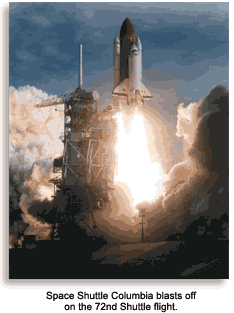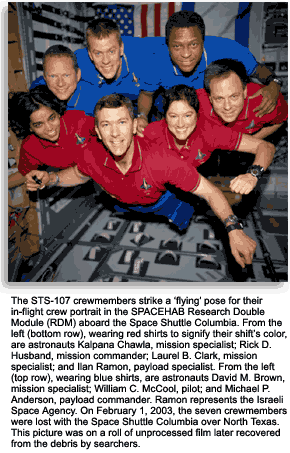Conceived as a means to reduce the cost of space flights, NASA's Shuttle Program originally was supposed to produce completely reusable vehicles, which would make launches routine and relatively cheap. Owing to the challenges posed by that scheme, the shuttle was later redesigned as semi-reusable. NASA’s previous space vehicles were costly because they were designed with the expendable launch-system technology, whereby each vehicle was launched, then discarded after one use. In semi-reusable form, the shuttle has completed dozens of successful missions, but two disasters have been etched into the nation's collective memory.
The original idea of reaching space in vehicles that resembled airplanes rather than rockets dates to before World War II. In 1951, Collier's printed a series of articles that popularized the possibility of manned exploration of space. The articles were the result of collaboration between Collier's editors and Wernher von Braun, who suggested that the United States should build a permanent space station and supply it with a vehicle that looked somewhat like the eventual space shuttle.
By the late 1960s, NASA began to worry about its future after the completion of the Apollo Mission. Budgets had already peaked and von Braun worried about staff reductions if no new projects appeared. The space shuttle was conceived as a means to make space exploration economical. The Saturn V rockets required by Apollo cost $185 million each, back when $185 million was a lot of money. The sum of all National Science Foundation grants at the time was around $440 million a year. Reducing the cost of launches was an obvious objective.
 The shuttle project was proposed and discussed extensively. Finally, on January 5, 1972, President Richard M. Nixon authorized the development of reusable vehicles for space exploration. The project became known officially as the Space Transportation System, and unofficially as the Space Shuttle Program.
The shuttle project was proposed and discussed extensively. Finally, on January 5, 1972, President Richard M. Nixon authorized the development of reusable vehicles for space exploration. The project became known officially as the Space Transportation System, and unofficially as the Space Shuttle Program.
The goal of 100-percent re-usability had been abandoned. The delta-winged Orbiter, which would contain a cargo bay and a crew compartment, would be put into orbit by its own rockets, assisted by two Solid Rocket Boosters (SRBs). In addition, an external fuel tank for the hydrogen and oxidizer required by the main engines was attached. The fuel tank would be jettisoned after use; the other components would be reused.
Work on the first orbiter began in mid-1974 by North American Rockwell (now owned by Boeing Company) and was completed in September 1976. North American Rockwell also produced the Apollo Spacecraft. The shuttle was designed for 100 launches, or 10 years of operation. As a result of requests by many Star Trek fans, it was named the Enterprise. It was used solely for testing and never completed an actual mission.
The first operational shuttle was the Columbia. Between April 21, 1981, and July 4, 1982, it performed four missions to demonstrate that the vehicle could be put into space, perform useful work, and return safely to Earth. After the fourth landing, NASA declared the shuttle ready for operation. In July 1982, the Challenger was added to the shuttle fleet. Later additions were the Discovery in 1983, Atlantis in 1985, and Endeavour in 1991.
In the first three-and-a-half years of shuttle operation, only 24 flights were completed, a figure below what NASA had estimated for each year when the project began. Nevertheless, the shuttle program accomplished a number of achievements during that period. In June 1983, Sally Ride became the first American woman in space and two months later, Guion S. Buford Jr. became the first African-American astronaut. The first American government official to reach space was U.S. Senator Jake Garn of Utah, who made the trip in April 1985 as a payload specialist. In January 1986, U.S. Congressman Bill Nelson flew on the Columbia, also as a payload specialist.
Disaster struck the space shuttle program on January 28, 1986. The Challenger disaster claimed the lives of all seven of its crew, including Christa McAuliffe, who was to be the first teacher in space. The repercussions of the Challenger loss brought the shuttle program to a halt for two and a half years. With a revamped design and solid-fuel rockets, the Discovery took off on September 28, 1988, marking the resumption of regular shuttle flights.
Following the Challenger disaster, the U.S. military dropped plans to use shuttles for military missions, and shuttles no longer launched commercial satellites. Despite those terminations, the shuttle has continued to play a central role in space exploration. Since 1986, the shuttle has launched the Magellan spacecraft to Venus, the Galileo spacecraft to Jupiter, and the Ulysses spacecraft to study the sun. The shuttle also deployed the Hubble Space Telescope, Gamma Ray Observatory, and Upper Atmosphere Research Satellite.
Astronaut John Glenn, the first American to orbit the Earth, returned as the oldest man to reach space as a member of the crew of Discovery on a nine-day mission in late 1998. The 77-year-old astronaut helped deploy the Spartan solar-observing spacecraft, the Hubble Space Telescope Orbital Systems Test Platform, and perform investigations on the aging process and on space flight.
In 1990, Discovery launched the Hubble Space Telescope, or HST. It was soon learned that a tiny flaw in the mirror was preventing the telescope from sending back completely clear images. A servicing flight by Endeavour in 1993 provided Hubble with corrective "eyeglasses," allowing the telescope to begin transmitting images of unprecedented quality. The Discovery returned in 1997 and 1999 to replace worn and outdated instruments. In March 2002, Columbia performed a similar mission.
 On February 1, 2003, Columbia broke apart during re-entry. All seven crew members were killed in the accident. Once again, the space shuttle program came to a thunderous halt. An investigation determined that one of the shuttle's thermal tiles had been damaged during takeoff, resulting in the failure of the protective shield when the shuttle returned to the atmosphere. Equipment and procedures were again modified and shuttle flights were scheduled to resume in the spring of 2005. Although Discovery would deliver supplies and cargo to the International Space Station in a new Italian-built Multi-Purpose Logistics Module, its main mission would be to test and evaluate the shuttle’s new safety procedures.
On February 1, 2003, Columbia broke apart during re-entry. All seven crew members were killed in the accident. Once again, the space shuttle program came to a thunderous halt. An investigation determined that one of the shuttle's thermal tiles had been damaged during takeoff, resulting in the failure of the protective shield when the shuttle returned to the atmosphere. Equipment and procedures were again modified and shuttle flights were scheduled to resume in the spring of 2005. Although Discovery would deliver supplies and cargo to the International Space Station in a new Italian-built Multi-Purpose Logistics Module, its main mission would be to test and evaluate the shuttle’s new safety procedures.
Even though the shuttle program has suffered two tremendous disasters, its dozens of successful missions have made great strides in space travel and exploration during its short history. The future of space exploration through the Space Shuttle Program may provide humanity with the answers to questions of their past and destiny. That future may include humans landing on Mars and perhaps even the establishment of colonies there.